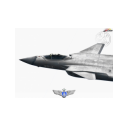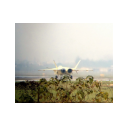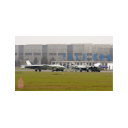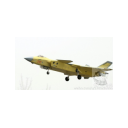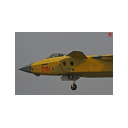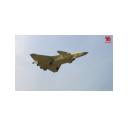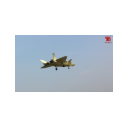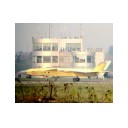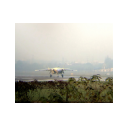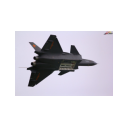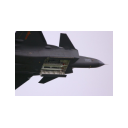Chengdu J-20
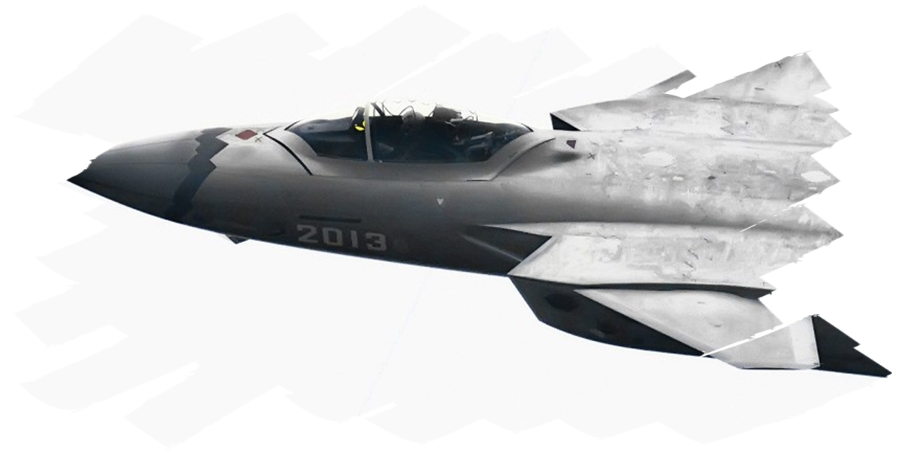
![]() The Chengdu J-20 Jian èr shí; literally "Annihilator Twenty") is a fifth generation stealth, twin-engine fighter aircraft prototype developed by Chengdu Aircraft Industry Group for the Chinese People's Liberation Army Air Force. In late 2010, the J-20 underwent high speed taxiing tests. The J-20 made its first flight on 11 January 2011. General He Weirong, Deputy Commander of the People's Liberation Army Air Force said in November 2009 that he expected the J-20 to be operational in 2017-2019.
The Chengdu J-20 Jian èr shí; literally "Annihilator Twenty") is a fifth generation stealth, twin-engine fighter aircraft prototype developed by Chengdu Aircraft Industry Group for the Chinese People's Liberation Army Air Force. In late 2010, the J-20 underwent high speed taxiing tests. The J-20 made its first flight on 11 January 2011. General He Weirong, Deputy Commander of the People's Liberation Army Air Force said in November 2009 that he expected the J-20 to be operational in 2017-2019.
Development
The J-20 was one of the stealth fighter programs under the codename J-XX that was launched in the late 1990s. It has been also designated "Project 718". Two prototypes (#2001-01 & #2001-02) have been built as of the end of 2010.
On 22 December 2010, the J-20 was under-going high speed taxiing tests outside the Chengdu Aircraft Design Institute with no confirmed flight tests. The J-20 made its first flight, which lasted about 20 minutes, on 11 January 2011.
Production and possible export
Globalsecurity.org states that China probably declined to participate in joint development and production of new fifth generation fighter with Russia given the belief that Russia stood to gain more from Chinese participation. Chinese leaders may have determined that their design was superior to the Russian PAK FA. Balkan military officials told the Associated Press that China and Russia may have adopted some stealth technology from a Lockheed F-117 Nighthawk, which was shot down by the Serbian military in 1999 during the Kosovo war. If Chinese experts used the F-117 stealth coatings, the result would be decades behind current American state-of-the-art. However, Chinese test pilot Xu Yongling said that the J-20 was a "masterpiece" of home-grown innovation, he also said the F-117 technology was already "outdated" even at the time it was shot down, and could not be applied to a next-generation stealth jet. Janes editor James Hardy agrees that it was unlikely China would have learned much from the wreckage.
Russian military commentator Ilya Kramnik conjectures that China is still 10 to 15 years behind the United States and Russia in fighter technology and may not be able to manufacture all the advanced composite materials, avionics and sensor packages needed for such aircraft, and could instead turn to foreign suppliers. However, he speculates that China may be able to produce the J-20 at a cost 50% to 80% lower than US and Russian fifth-generation jet fighters, and that potential customers may include Pakistan, the Middle East, Latin America, Southeast Asia and the richest countries in Africa. Bill Sweetman speculates that China will have problems meeting its production requirements, as it has several other jet fighter projects in production. Aviation Week raised the question of whether the aircraft is a prototype, like the Sukhoi T-50, or a technology demonstrator similar to the Lockheed YF-22.
Despite a current arms embargo, China may use ongoing economic problems to pressure the European Union into selling advanced military technologies, such as those needed to complete the J-20.
Design
Characteristics
The J-20 is a single-seat, twin-engine aircraft which appears to be somewhat larger and heavier than the comparable Sukhoi T-50 and Lockheed Martin F-22 Raptor. Bill Sweetman estimates that it is approximately 75 feet (23 m) in length, has a wingspan of 45 feet (14 m) or more, and is expected to have a takeoff weight of 75,000 to 80,000 pounds (34,000 to 36,000 kg) with internal stores only. The prototype could be powered by twin 32,000 pounds (15,000 kg) thrust Saturn 117S engines provided by Russia. Chinese sources have claimed that production aircraft will be powered by two 13,200 kilograms (29,000 lb)/WS-10 class high thrust turbofan engines fitted with Thrust Vector Controlled (TVC) nozzles, both made in China. Pentagon spokesman Col. David Lapan has said that one of the signs of problems in the development is that China is still seeking engines from Russia for the aircraft.
The J-20 may have lower supercruise speed (yet greater range) and less agility than a Lockheed Martin F-22 Raptor or PAK FA, but might have larger weapon bays and carry more fuel. The J-20 has a long and wide fuselage and low jet engine intakes with a forward chine, a main delta wing, forward canards, a bubble canopy, conventional round engine exhausts and canted all-moving fins. The front section of the J-20 is similarly chiseled as the F-22 Raptor and the body and tail resemble those of the Sukhoi T-50 prototype. As early photographs of the prototype surfaced, Bill Sweetman commented that the design may suggest a large, long range ground attack aircraft, not unlike a "stealth version" of the General Dynamics F-111 Aardvark. Douglas Barrie has noted that the canard-delta configuration with canted vertical fins appears to resemble the MiG 1.42. Yet, Barrie notes that key differences include greater forward fuselage shaping as the basis for low observable characteristics, along with the different engine intake configuration. It is suspected that cyberespionage may have assisted the development of the J-20, with information used by subcontractors of Lockheed Martin for the F-35 project in particular having been significantly compromised during development of the J-20.
The J-20 has a pair of all-moving tailfins that are swept back in the F-35 style instead of being trapezoid like the F-22 and PAK-FA tails and ventral stabilizing fins. It also has an F-22 style nose section, but with F-35 style dropped nose, forward swept intakes with "diverterless" supersonic inlet (DSI) bumps and a one-piece canopy. It was reported in November 2006 that a T/W=10 17,000 kilograms (37,000 lb) class turbofan (WS-15/"large thrust") was being developed for the J-20. One (#2001-01) prototype is fitted with AL-31F, the other (#2001-02) is fitted with the improved WS-10G with a new "stealth" nozzle possibly to reduce RCS and IR emission.
The J-20 may become the first operational combat aircraft that carries sufficient fuel to supercruise throughout its missions, doubling its sortie rate.
Pentagon spokesman Geoff Morrell has said that it was premature to call the J-20 a stealth fighter or to judge if it had any other fifth generation characteristics.
Avionics
The production J-20 may incorporate an advanced fly-by-wire (FBW) system fully integrated with the fire-control and the engine systems. Its fire-control radar is expected to be Active Electronically Scanned Array (AESA) (Type 1475/KLJ5).
Cockpit
The aircraft features a "pure" glass cockpit (two large color liquid crystal display (LCD) and several smaller ones and a wide-angle holographic head-up display (HUD)). Many of these subsystems have been tested onboard J-10Bs to speed up the development.
Armament
The J-20 has a large belly weapon bay for short/long-range air-to-air missiles (AAM) (PL-10, PL-12C/D & PL-21) and two smaller lateral weapon bays behind the air inlets for short-range AAMs (PL-10).
Stealth
Dr. Carlo Kopp has suggested that the J-20's overall stealth shaping is "without doubt considerably better" than the F-35 and PAK FA. He agrees with others, such as Shih Hiao-wei of Defense International monthly and Bill Sweetman of Aviation Week, that the excessive number of airfoils on the J-20 will challenge its ability to remain stealthy from all directions. As of January 2011 the engine nozzles were clearly non-stealthy; this may be due to the fact that the final "fifth generation" engines had not been completed yet. However, one of the prototypes uses WS-10G engines with stealthy jagged-edge nozzles and tiles.
Robert Gates has also questioned how stealthy the J-20 might be although he did say the development of the J-20 had the potential to "put some of our capabilities at risk, and we have to pay attention to them, we have to respond appropriately with our own programs." Furthermore, Gates said that U.S. intelligence may have underestimated Chinese progress in the development of the aircraft, although he would add that, "my general line for those both at home and around the world who think the U.S. is in decline is that history's dustbins are filled with countries that underestimated the resilience of the United States."
Kopp and Goon have further speculated that the J-20 is designed to operate as a heavy interceptor, destroying opposing AWACS and tanker aircraft. If true, this would make it more similar to a MiG-25 with stealth capability. Sweetman agrees that this is the most likely role for such a large aircraft with low thrust to weight ratio and limited agility that is optimized for range and speed. Lewis Page has said that it is unlikely that the Chinese will soon have an American style Low Probability of Intercept Radar and so the J-20 would be limited to attacking ground targets like previous generations of American stealth aircraft such as the Lockheed F-117 Nighthawk. In that case the J-20 would carry a radar, but using it would instantly give away its location. However, the J-20 is expected to use a AESA radar, which should have Low Probability of Intercept modes. Given that the F-35 can already track and jam even the F-22's radar, this might not be sufficient.
Loren B. Thompson has said that this combination of forward sector only stealth and long range will allow the J-20 to make attacks on surface targets while the United States lacks sufficient bases for F-22s in the area to counter these attacks and American allies have no comparable aircraft.
A canard delta offers greater efficiency in both subsonic and supersonic flight (which may help supercruise range), but it is unknown if the Chinese have the same software used on the Eurofighter Typhoon to control the otherwise non-stealthy canards. Teal Group analyst Richard Aboulafia has also raised doubts about the use of canards on a design that is intended to be low-observable: "There's no better way of guaranteeing a radar reflection and compromise of stealth". Nevertheless, canards greatly boost the aircraft's maneuverability over that of a pure delta wing without canards. Sweetman notes that the canard delta works with the Whitcomb area rule for a large-volume mid-body section design. Also, while the DSI intakes are easier to maintain than more complex stealth-compatible intakes, such as on the F-22, their fixed form limits the aircraft to around Mach 2.0. J.D. McFarlan of Lockheed Martin has said that the J-20 DSI inlets resemble those of the F-35, but it is unclear if the Chinese have perfected their own design.
United States House Committee on Armed Services chairman Howard McKeon said on the J-20 "my understanding is that they built it on information that they received from Russia, from a Russian plane, that they were able to copy".
Operational history
On 22 December 2010, the J-20 was under-going high speed taxiing tests outside the Chengdu Aircraft Design Institute with no confirmed flight tests. Several Chinese military websites and photos revealed that on 10 January 2011 Chinese Vice President Xi Jinping and Chairman of the Standing Committee of the National People's Congress Wu Bangguo came to the Chengdu facility to witness the first flight test. The test flight was cancelled that day due to bad weather.
Flight testing
The J-20 made its first flight, which lasted about 20 minutes, on 11 January 2011. A Chengdu J-10S served as the escort aircraft. China thus became the third nation in the world to "develop and test-fly a full-size stealth combat aircraft demonstrator", after the United States and Russia. The Guardian reported that experts, on the one hand, expressed "surprise" at the speed with which the aircraft was developed, but on the other hand "said the country's military prowess was still relatively backward and way behind that of the US" and that its military interests were limited to its region.
The first test flight coincided with a visit of United States Secretary of Defense Robert Gates to China, and was initially interpreted by Pentagon officials and media pundits as a possible signal to the visiting delegation from the U.S. However, after meeting with senior Chinese officials including Chinese President Hu Jintao, Secretary Gates remarked, "The civilian leadership seemed surprised by the test and assured me it had nothing to do with my visit." Jin Canrong, a professor at Renmin University in Beijing who specializes in China-U.S. relations, suggested that President Hu's ignorance of the test raises questions about the nature of civilian control of the Chinese military. However, as Michael Swaine, an expert on the PLA and United States - China military relations, explained, although it's possible and even likely that "senior officials in the [Chinese] leadership did not know that this flight test would occur on this precise day," this is not necessarily evidence of a military-backed effort to insult Secretary Gates' delegation or embarrass President Hu. Rather, decisions regarding the production, development and testing of such military aircraft are routinely managed by engineers and low-level officials more than by senior civilian or military leadership. Coupled with the fact that there was relatively limited coverage of the event in Chinese media initially, it is likely that the test may not have been considered a significant enough event to warrant notification to President Hu. Moreover, the Chinese military has conducted important tests (including the 2007 anti-satellite missile test) on 11 January in the past; thus, the test may have been related to this.
Specifications
Because the aircraft is in development, these specifications are preliminary and are taken as estimates from the available images.
General characteristics
Crew: 1
Length: 75 ft (23 m)
Wingspan: 45 ft (14 m)
Height: ()
Max takeoff weight: 75,000-80,000 lb (34,000 - 37,000 kg)
Powerplant: 2× WS-10G thrust-vectoring turbofan (155 kN) on production aircraft. Possible WS-15 on production aircraft.
Performance
Cruise speed: Mach 1.5 (estimated)
Combat radius: Estimated at 1,000 nautical miles (1,852 km)
Armament
Guns: None on prototype.
Expected to have internal and external hardpoints for missiles, bombs and fuel tanks.
Avionics
Anticipated AESA radar with LPI modes for use against air and surface targets, and low observable data links, infrared missile warning and radar warning sensors.


